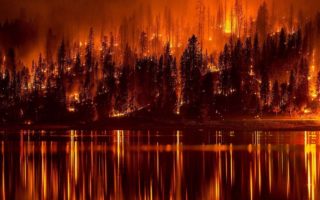
The ongoing series of wildfires raging in the Western United States has continued to drive down air quality in the Pacific Northwest. The smoke and ash created by the fires has reached as far as Arizona, but is at its worst in the areas immediately nearby the burning forests. Here’s what you need to know about current Pacific Northwest air quality and how you can protect yourself from wildfire smoke if you live in the region.
How Bad is Air Quality in the Pacific Northwest Currently?
Although wildfires are never beneficial for air quality, few have produced the extreme drops seen in recent days. In Portland, Oregon, this week, the air became so saturated with smoke that road travel was actively discouraged due to visibility issues. Along with other parts of Oregon, Portland saw air quality ratings considered to be hazardous to human health as a result of the ongoing fires.
The problems haven’t been confined to Oregon, though. Earlier this week, Seattle rated as having the third lowest air quality in the world. The smoke in the Seattle area has been so thick that it has resulted in cooler daytime temperatures by blocking out sunlight.
All of this is to say that overall air quality in the Pacific Northwest is near record lows. Residents are forced to contend with smoke and ash that could result in serious health effects. Worst of all, low air quality has been associated with higher risks of COVID-19, meaning that the wildfires could also result in a worsening of the pandemic in affected areas.
How Harmful Can Wildfire Smoke Be?
At first glance, one might not think that wildfire smoke would be especially harmful to human health. However, the health effects of low air quality and fine particulate matter have been well demonstrated. People suffering from existing respiratory diseases can be much more prone to attacks during periods when air quality is low. In the long term, inhalation of fine particulate matter can also contribute to the development of new respiratory illnesses, as well as increased risk of cardiac conditions and certain cancers.
What Steps Can You Take to Limit Your Exposure?
If you’re in the areas affected by the current wildfires, there are several steps you can take to keep your smoke exposure at a minimum. First and foremost, it’s important to limit your time outside. Indoor air can be circulated in your house, preventing smoke and ash from being drawn in from the outside. The more time you can spend indoors until the Pacific Northwest’s air quality improves, the better off you will be.
If you do have to go out, consider wearing a facial covering to filter out some of the fine particles that make up the smoke. These days, most of us are used to wearing face masks as a means of controlling COVID-19 spread, but they can also help to keep at least some of the components of smoke out of your lungs. If you have an N-95 mask, this is the best choice. However, even a cloth face covering will help to some extent.
Finally, you can use a high-quality residential air purifier in your home. Even without letting air in from the outside, some smoke is bound to get into your home if you’re in a heavily affected area. Using an air purifier can help keep your indoor air cleaner and reduce any smoke that does manage to make it in. We offer a complete selection of air purifiers for wildfires that can be used for extra protection in the home.
Have more questions about how an air purifier can help to protect you from the harmful effects of wildfire smoke? We’re here to help! We’ll be happy to provide you with answers to your questions, as well as personalized product recommendations based on your needs and the size of your home.